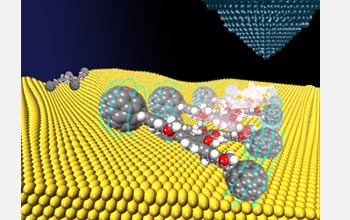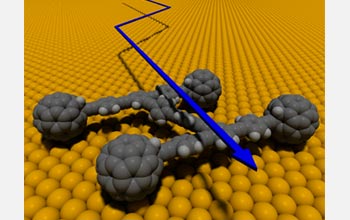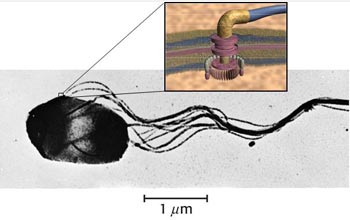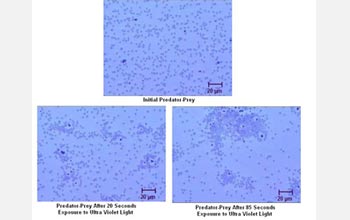All Images
News Release 09-080
"Fantastic Voyage" Not So Far-fetched
Studies yield clues to powering nano-sized machines
This material is available primarily for archival purposes. Telephone numbers or other contact information may be out of date; please see current contact information at media contacts.

Single-molecule nano-vehicles synthesized by researchers at Rice University in Texas measure just 4x3 nanometers and have four carbon-based buckyball wheels connected to four independently rotating axles and an organic chemical chassis.
Credit: T. Sasaki/Rice University
Download the high-resolution JPG version of the image. (1.9 MB)
Use your mouse to right-click (Mac users may need to Ctrl-click) the link above and choose the option that will save the file or target to your computer.
Silver chloride colloids (darker objects) are mixed with 2 µm silica spheres (translucent objects) in deionized water. UV-illumination commences three seconds into the film, and the silver chloride begins to move. The inert silica spheres are then seen to seek out and surround the mobile silver chloride particles in much the same way a neutrophil seeks out bacteria. Scientists say autonomous nano-machines could take on similar characteristics, moving independently by harvesting energy from light, glucose or other abundant fuels in biological or organic systems.
Credit: Michael Ibele, Thomas E. Mallouk, and Ayusman Sen
Angew. Chem. 2009

James Tour and coworkers at Rice University synthesized a molecular car with four carbon-based wheels that roll on axles made from linked carbon atoms. The nano-car's molecular wheels are 5,000 times smaller than a human cell. A powerful technique that allows viewing objects at the atomic level called scanning tunneling microscopy reveals the wheels roll perpendicular to the axles, rather than sliding about like a car on ice as the car moves back and forth on a surface.
Credit: Y. Shirai/Rice University
Download the high-resolution JPG version of the image. (2.4 MB)
Use your mouse to right-click (Mac users may need to Ctrl-click) the link above and choose the option that will save the file or target to your computer.

Powering nano-vehicles is a complex issue yet to be solved. Researchers know that external electric or magnetic fields could create small forces that cause the tiny machines to rotate or undergo intricate motions. But, they say, that approach would cause every nano-machine in the field to move in lock-step. Autonomous movement is preferred for uses such as microsurgery when machines need to move independently. Researchers look to biology for clues that could lead to an effective, self-directed nano-motor. Here, the tail-like structure of a Salmonella bacterium turning in a corkscrew motion and powered by stored chemical energy provides an example of how nano-machines could be autonomously powered.
Credit: Electron micrograph: J. A. Illingworth, Supercharged Cells, http://www.bmb.leeds.ac.uk/illingworth/6form/index.htm. Graphic: M. McDarby, Online Introduction to Biology (Advanced), Chapter 4, Cell Structure and Function, 2008.
Download the high-resolution JPG version of the image. (30 KB)
Use your mouse to right-click (Mac users may need to Ctrl-click) the link above and choose the option that will save the file or target to your computer.

The study of bacteria offers some intriguing theories for building autonomous nano-motors. One theory involves phototaxis--particle motion driven by light in which particles move towards or away from the region of highest light intensity. Movement depends on the nature of the ions given off by a lighted particle and the charge of the particle. The phenomenon can lead to biomimetic cooperative behavior, such as one in which some particles act as "predators" and others as "prey," very much like white blood cells chasing down a bacterium. The design of "smart" autonomous nano-robots could take on similar characteristics, moving independently in a needed direction by harvesting energy from light, glucose or other abundant fuels in biological or organic systems. Here, two different particles engage in phototaxis "predator-prey" movement. Dark silver chloride particles when stimulated by UV light emit positively charged ions. These ions propel the movement of the silver chloride particles, but they also cause attraction of the lighter colored silica particles. Consequently, the "prey" particles are eventually surrounded by "predators." The silver chloride particles are shown first in a neutral state, and then they are photographed after 20 seconds of exposure to UV light and again after 85 seconds of exposure. The exposure causes them to be surrounded by silica particles that are attracted by the ions. The results cause researchers to hypothesize that nano-engines using similar technologies may not be that far away.
Credit: Michael E. Ibele, Thomas E. Mallouk, and Ayusman Sen, Angew. Chem., in press
Download the high-resolution JPG version of the image. (48 KB)
Use your mouse to right-click (Mac users may need to Ctrl-click) the link above and choose the option that will save the file or target to your computer.


